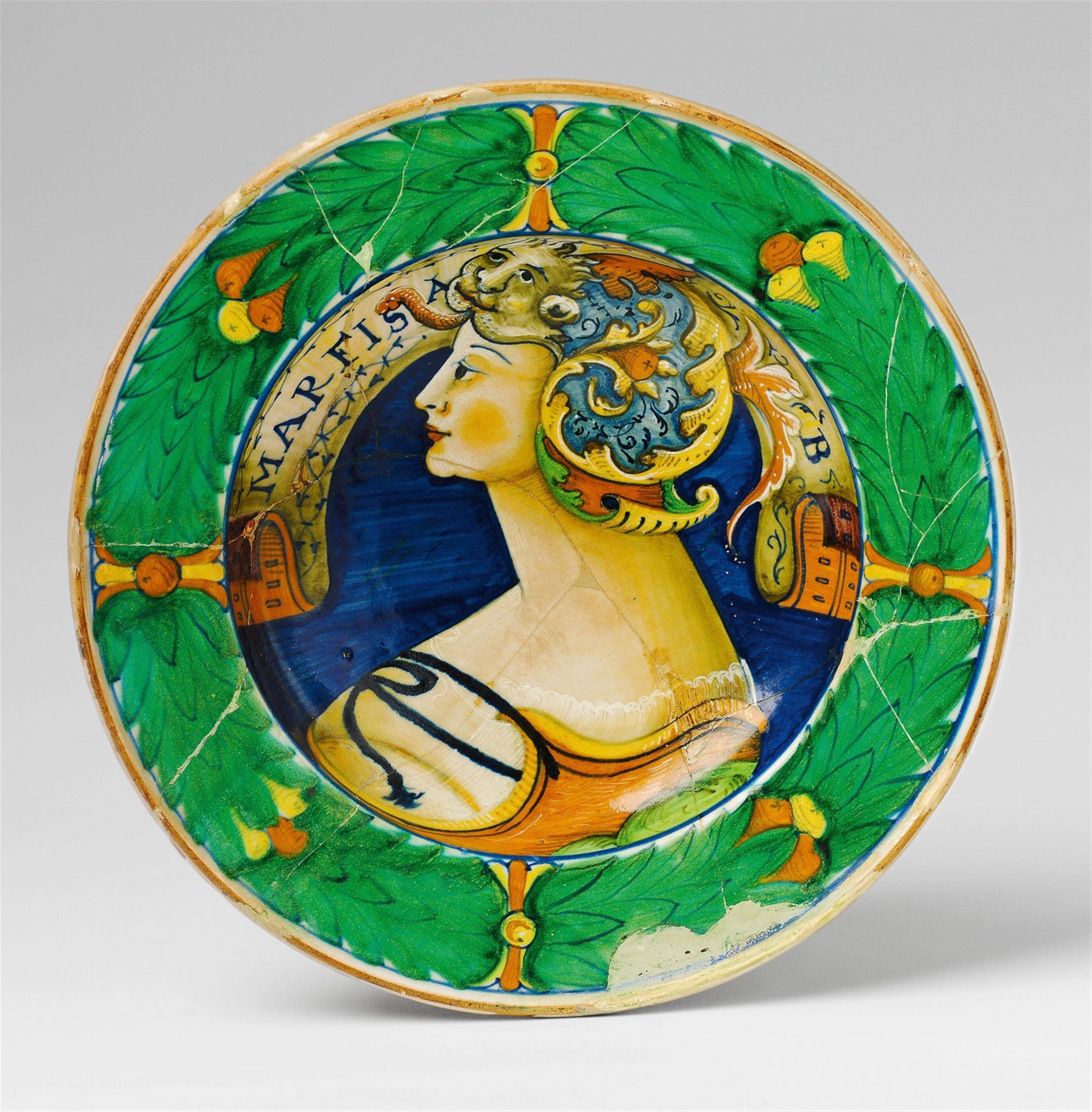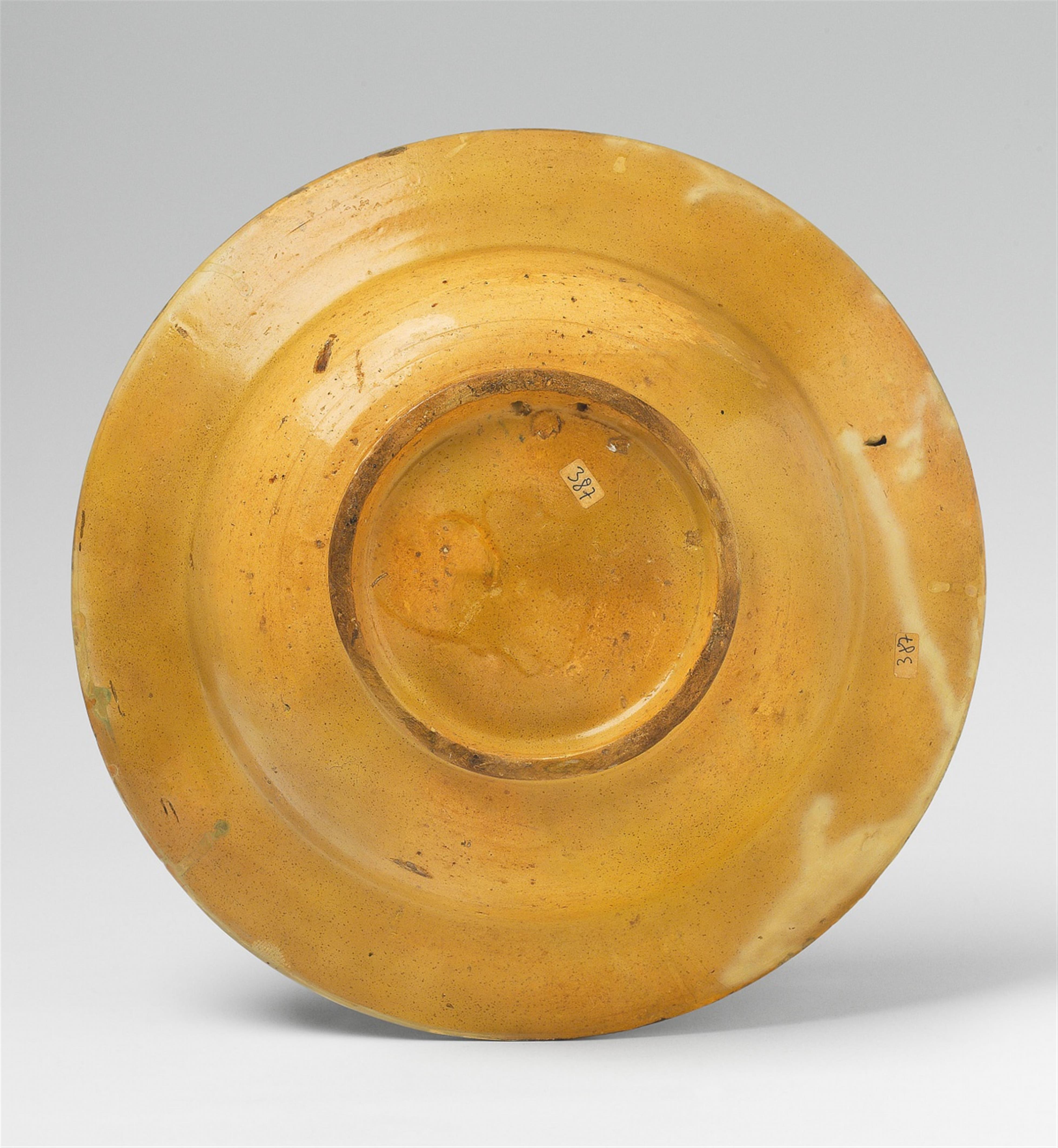An important Renaissance maiolica platter
A large, moulded plate with basal ring. Decorated to the centre with a female portrait in profile with a decorative helmet, beneath a banderole reading "MARFISA B." The face outlined in blue with pale ochre coloured skin and blue strands of hair, finely highlighted in white. Bordered by a laurel and fruit wreath. Broken and restored with minor additions, probably between 1905 and 1939. D 33.7 cm.
Siena or Urbino, ca. 1520 - 30.
The platter illustrated in the catalogue of the Pringsheim collection is not identical to the current work. The differences are presumably due to an uncovered/amended restoration.
We assume that this plate's most illustrious previous owner was probably Alfred Pringsheim (Ohlau 1850 - 1941 Zurich), a professor of mathematics at the Ludwig-Maximilians University and a member of the Bavarian academy of sciences as of 1898. He was born into a wealthy merchant family, which allowed him to build up an important art collection, focussing on Italian maiolica and silver. He was so knowledgeable in this field that he became a member of the purchasing committee of the Bayrisches Nationalmuseum. He led a comfortable bourgeoisie life, residing sumptuously in Arcisstr. 12 (today Katharina von Bora Str. 10), where he regularly received important guests from Munich high society. In 1901, his daughter Katharina Hedwig became the first female recipient of an “abitur” in Munich, and in 1905 she married the young Thomas Mann, who was already a well-known author.
Alfred Pringsheim became a professor in 1922. However, around this time, the effects of hyperinflation and the financial crisis hit him hard, and he was forced to sell off parts of his collection in order to survive. He coined the phrase “living from wall to mouth”. Although he considered himself a German patriot and of no religion, in the following years his Jewish heritage was to lead to his downfall. His house was foreclosed and auctioned by the NSDAP in 1933, and he subsequently moved to Widenmayerstr. 35. His art collection was sold under Nazi instigation at Sotheby's in 1939, and he was forced to use the results to pay the Reich Flight Tax. The famous collection of 435 pieces of maiolica was then scattered throughout the world, with some pieces finding new homes in the collections of famous museums such as the Louvre and the British Museum. Forty-nine pieces were also integrated into the Lehmann Collection in the Metropolitan Museum in New York. The Jewish Museum in Munich paid tribute to this important German collector and patron in the 2007 exhibition “Nichts als Kultur - die Pringsheims“.
Provenance
The Somzée Collection, Brussels
The Bourgeois Collection, Cologne (not in Lempertz catalogue 1904)
The von Pannwitz Collection, auctioned by Galerie Helbing, Munich, on 24th and 25th October 1905, lot 257.
Probably part of The Alfred Pringsheim Collection, auctioned by Sotheby´s London, 7th and 8th June 1939, lot 94.
According to the list of results, the piece was then in the possession of one Mr. Backer
Auctioned in London in 1970, consigned by the descendants of the buyer.
Literature
In: Falke, Die Majolikasammlung Alfred Pringsheim, Reprint 1994, 2nd vol., no. 231, pl. CXIX. There catalogued as: "Toskana, maybe Siena, ca. 1530". Cf. a plate with a similar motif in the Berlin Kunstgewerbemuseum attributed to Tjark Hausmann Nicolò da Urbino (Hausmann, Majolika, Berlin 1972, no. 175). Hausmann lists a piece with a wreath in the Museo Civico in Pesaro, inscribed "FAUSTINA" and dated 1522 (ibd. p. 239 f.).
Exhibitions
Exhibited in Düsseldorf in 1902.




